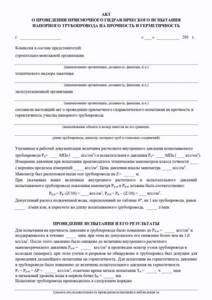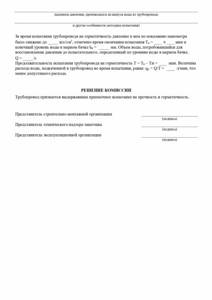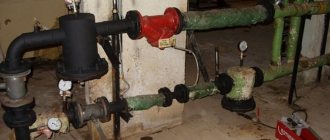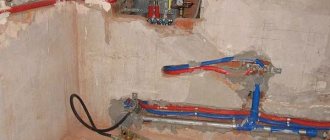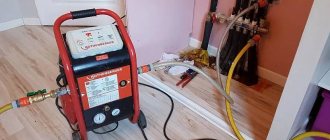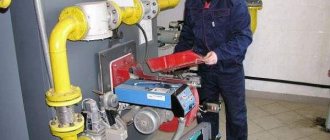Document year: 2019
Document group: Acts
Type of document: Act
Download formats: DOC, PDF
Test reports are drawn up in the form of document forms in which the results of testing the performance of mechanisms and equipment are recorded.

In today's article, we will consider in detail the testing of pipeline systems, sewerage systems, stairs and stepladders, roof fencing and fire tests.
Examples of drafting acts can be downloaded for free at the end of the article.
Hydraulic testing report for the heating and water supply pipeline system
Checks of heating and plumbing systems are carried out:
- when introducing new engineering communications;
- when reconstructing an existing one;
- during a routine check of the functioning of the system.
The step-by-step inspection and its results are recorded in the test report. The system is tested for tightness and strength in two ways, one of which is the hydraulic method: testing by using water with increased load. This method is suitable for indoor and outdoor systems (at temperatures not lower than +5C). The second method is pneumatic.
Both methods of acceptance testing are called pipe testing.
The results of the inspections are recorded in a report, the form of which is established by the Code of Rules for building codes and regulations. The template is presented in Appendix 1 to SANPin “External networks and structures of water supply and sewerage.” The presented form of the act is mandatory.
Procedure for drawing up the act:
1. Indication of general organizational information: city of compilation and date.
2. Representation of the members of the commission that carried out the pressure testing and acceptance of the pressure pipeline. Three parties become members:
| The company that installed the pipeline |
| Technical supervision representative from the customer |
| Operating company representative |
3. Below is information about the inspected object and a description of the pipeline (length, diameter, material of pipes and joints), information specified in the working documentation is given, and information about the pressure gauge used is given.
4. The section about the test and its results is completed.
5. In the section “Decision of the commission” there is a statement that the system is considered strong and airtight and this is signed by the members of the commission.
You can download the form for free at the end of the article.
Documentation of the work performed - act
The pressure test certificate is an official document with legal force confirming that:
- tests were carried out in full according to the program developed by the engineer, in accordance with current standards;
- the heat supply system is in working order and prepared for operation;
- in the event of an emergency during the heating season, one or both parties will be responsible for it, and the culprit will compensate for the damage.
In the form of an act for hydraulic testing of the heating system, there are columns that must be filled out completely and as accurately as possible.
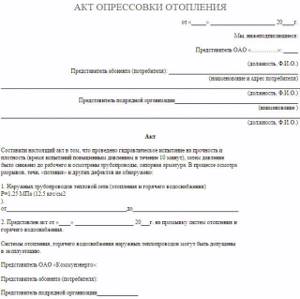
They indicate:
- name of the object being checked;
- date and time of the pressure test;
- the tested area, which can be, for example, a heating main or a separate unit;
- devices used;
- results of visual inspection of joints, seams, etc.;
- the magnitude of the operating pressure and load on the system and the duration of the tests;
- values on the pressure gauge at the end of the test;
- the magnitude of the pressure drop;
- information on eliminating leaks and other defects;
- conclusion that the system is ready for operation;
- signatures of authorized persons.
The heating main pressure test certificate is signed on the day the system was tested. This document must be endorsed by the responsible persons of the enterprise that carried out the work, as well as the technical supervision body and the management company.
Certificate of pneumatic testing of pipelines
Pneumatic method: diagnosis by pumping the system with high pressure air. Often the method is used for external systems if the temperature on the thermometer is less than +5 Celsius.
The procedure for crimping pipes by pneumatic testing is given in the same SanPiN; the test report is drawn up in the required form, which is given in Appendix No. 3.
Requirements for drawing up test documentation:
- Filling in the name of the city and the date of compilation.
- Indication of the members of the commission (as in the hydraulic test, three parties are involved).
- Description of the pipeline: length, diameter, material of pipes and joints.
- Information about the pressure value: calculated value, to what value the pressure in the pipes was increased, final pressure, amount of reduction. The crimping time is indicated.
- In the “Decision of the Commission” section, each of its members signs with a transcript if the pipeline has passed pneumatic diagnostics and is sealed and durable.
Pressure testing technology in an apartment building
The crimping procedure is carried out according to a single algorithm; the procedure has some peculiarities in different cases.
Special services are required to carry out hydraulic tests before and after the heating season.
This event is also carried out after repair or when commissioning equipment.
The outcome of the event is documented and a corresponding act is drawn up.
Before crimping the following is carried out:
- inspection of the supply unit, pipeline and other parts of the system.
- checking the condition of the thermal insulation of the main line.
When used for more than 5 years, it is recommended to flush the system before hydraulic testing. For this purpose, a special solution is poured into the pipes freed from coolant.
Having completed these activities, they proceed to crimping. The actions are in the following order.
- Water is poured into the newly installed or flushed system.
- Using special injection equipment, increased pressure is created, which is controlled by a pressure gauge.
- If the pressure level remains unchanged for 15-30 minutes, then this indicates the tightness of the system and the reliability of the equipment included in it.
- If a decrease in pressure is observed, the reason for this is determined.
- Having found out the place where the leak occurs, it is eliminated or the faulty element is replaced and the procedure is repeated.
- The test is considered successful if the pressure drops no more than 0.1 atm over 30 minutes.
Certificate of testing of external and internal sewerage for spillage
A test report for internal and external sewerage is drawn up as a result of checking the operability of the system. It confirms the position of the commission that the system has withstood the test of a spill of water, and the design complies with the design documentation, GOSTs and standards.
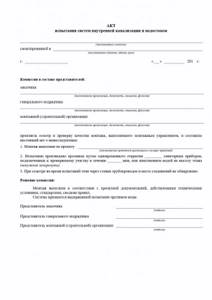
Diagnostics of the normal functionality of the sewer system is necessary when installing a new facility or after carrying out repair work on an existing system. Information about the performance check is entered into the report. The form is drawn up in the form specified in Appendix “D” to the Code of Rules 73.13330.2012.
The act specifies:
- name of the system and the facility in which it is installed;
- information about the members of the commission. Representatives of three organizations are needed: the general contractor, the customer and the installation company;
- information about the name of the project is written down;
- the results are entered: the number of simultaneously connected devices, as well as the connection time or filling of water on the floor (unnecessary ones are crossed out);
- the third paragraph states that no leaks were detected at the joints and through the walls. This means the system is suitable for use.
The decision is signed by the members of the commission.
Hydraulic crimping
There are two ways to test the system - hydraulic and air. Let's look at each of them in more detail.
So, the hydraulic pressure testing method involves filling the assembled and ready-for-test system with water, and creating hydraulic pressure in it, as a result of which leaks and weak points must be detected. For example, for a system made of Rehau pipes, the test is carried out within three hours. In this case, the working pressure in the system is ensured for the first two hours, and during the third hour it should be 30% higher.
In Russian realities, the reliability of the heating system is checked at a pressure of a maximum of 10 bar. In this case, it is imperative to check that both the pipes and all components of the system (manifold, etc.) are designed for a maximum operating pressure of at least this value.

Table for checking pipe pressure
Fire test reports
During testing for the performance and safe operation of fire equipment, several reports are drawn up:
- checking fire hydrants;
- diagnostics of internal water supply;
- checking for the safety of use and compliance with labor protection rules of fire escapes.
Fire hydrants
Testing the performance of hydrants for water loss is carried out twice a year and is often combined with checking the fire-fighting water supply system. Based on the results of the inspection, an act is drawn up and signed by the commission. Mandatory members: a representative of the fire inspection and a representative from the organization in which the inspection is taking place. Also, the commission may consist entirely of company employees.
The act states:
- general organizational information (information about the company, date and place of compilation);
- the main part describes the members of the commission and the progress of the test. Information about hydrants is presented in tabular form. The location address, diameter, pressure, water yield and affiliation of the hydrant are indicated;
- in the final part, compliance (or non-compliance) with the requirements of the hydrant condition is established.
At the end, the act is signed by authorized members of the commission.
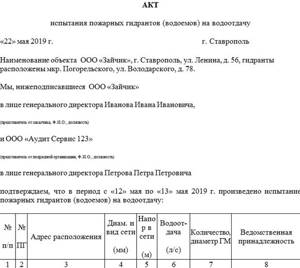
Internal fire water supply
The act establishes the presence or absence of defects and malfunctions in the fire water supply system. The inspection is carried out by responsible employees of the enterprise. Frequency – at least twice a year; for flammable industries, inspections may be scheduled more often.
Internal fire water supply (IFP) is a complex system of pipes, sensors, and switches. Therefore, it is often checked by a labor protection or fire safety specialist, as well as by persons who are trained in fire safety.
The act is drawn up on letterhead or plain paper indicating the details. Be sure to register:
- information about the organization and participants of the inspection;
- information about the object being checked;
- inspection results;
- recommendations for eliminating defects and malfunctions, if any are found;
- signatures of responsible persons.
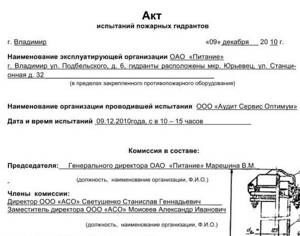
If additional documents are attached to the act, their list and name are indicated.
Fire escapes
Testing of firefighting equipment, including ladders and stepladders, is regulated by a special GOST. Inspections can be carried out by organizations that have received permission from the Ministry of Emergency Situations and have special equipment for this.
The test results are recorded in the test report. The documentation provides standard information about the organization and its details, information about the members of the commission. The main part provides information about the inspected objects (number of ladders and stepladders, their inventory numbers and affiliation with the structural unit), information about the results of inspections (absence or presence of defects). An instruction is given to eliminate the identified faults.
At the end, the act is signed by the members of the commission.
Roof fencing test report
Technical requirements and roof testing methods are enshrined in the same GOST as the standard for fire escapes and stepladders (53254-2009).
Tests are carried out at intervals of five years, integrity checks are carried out every year. The results are documented in acts.
The conditionally completed act can be divided into three parts:
- General information. Information about the tested object and the inspecting organization is entered here.
- Information about the inspection (what manipulations were carried out, what tools were used).
- Test results (compliance with GOSTs, integrity and safety of the structure).
The agreement of the commission members during testing is confirmed by their personal signatures.
Organizations with a license from the Ministry of Emergency Situations have the right to conduct inspections and tests. Defects found must be corrected.
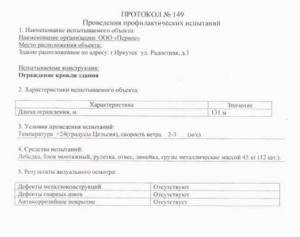
Test report for ladders, racks and stepladders
Inspection and testing of racks, ladders and stepladders is carried out at least once every six or twelve months (depending on the object being tested and the material from which it is made).
Tests and checks for safe operation can be carried out by specialized organizations from outside or a commission specially created at the enterprise. At the same time, its members must be trained; an occupational safety or fire safety engineer is usually appointed as the chairman of the commission.
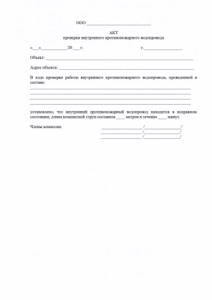
As a result of the diagnosis, the commission draws up a report; it is better to document it with the date of the inspection. The header indicates the name of the document, date and place of compilation. It is also important to indicate the details of the organization, list the members of the commission: their positions and full names.
In the main part, describe the tests of stepladders, ladders and racks:
- how many were checked, their inventory numbers, belonging to the workshop and department;
- what load was used and for how long;
- presence and absence of defects;
- availability of an assigned inventory number.
As a result of the test, suitability (or unsuitability) for use is established: they are safe, can withstand the required load, do not have defects in connections and fastenings, do not have sharp edges or burrs.
The signing of the act by the commission members indicates agreement with the results of the inspection.
By the way! If after this article you still have questions about how to fill out the forms, contact the site’s on-duty lawyer.
What is pressure testing of a heating system - test objectives. Press!
To put a heating network or water supply into operation, as a result of all important installation work, the assembled structure must be tested.
At this stage, hydraulic checks are carried out, based on the results of which a report is drawn up indicating the suitability of the system for use in the target area and its ability to withstand hydraulic shocks.
Purpose of testing
Conducting hydraulic tests is not a whim or a whim.
Inspections are primarily carried out after the creation of a new network or as a result of major repairs, preventive measures and reconstruction of an existing one, and primarily before the start of the heating season.
After this, a new test is performed, and this continues until the results required by the standard are obtained. Actually, there are two stages of testing: primary and final.
Please note: pressure testing is being carried out to check the tightness and integrity, as well as the presence of expected defects in each section of the water metering unit, including boilers.
Similar checks are a fairly popular process for testing heating systems. This happens by simulating water hammer, when pressure is pumped into the system many times higher than the standard one.
Note from a professional: all defects and defects discovered at the time of crimping must be eliminated without delay and without delay.
All rules for conducting inspections of a similar nature are always strictly regulated.
For hydraulic tests, standards are used. These are two SNiPs: 41-01-2003 and 3.05.01-85, and also “Rules for the technical operation of thermal power plants” from 2003.
The test procedure is quite transparent and understandable:
